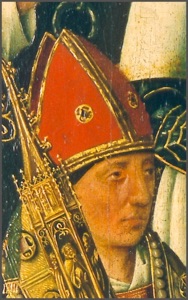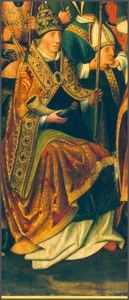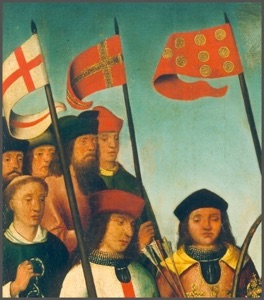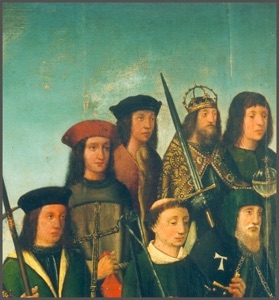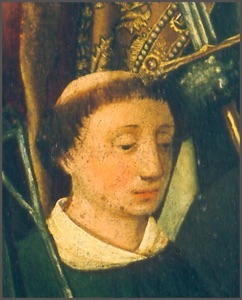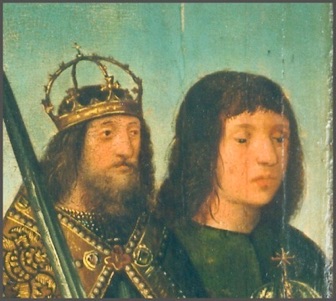Paneel
Zuidnederlands of Keuls meester
Zuid-Nederland of Duitsland
1500-1530
Alegorisch tableau met 18 heilige christusmartelaren.
Rechtsboven 2e van rechts staat Karel de Grote, afgebeeld met de kroon, het zwaard en de rijksappel. De onthoofde persoon is bisschop Dionysius, patroonheilige van Parijs. (werd door keizer onthoofd en niet begraven, waarop hij zelf zijn hoofd wegbracht.) De man met de handboeien links in het midden is de H. Leonardus, gest.559 te Limoges, beschermheer van de gevangenen en slaven. Naast hem staat de H. Tropes, Romeins officier, onthoofd, patroonheilige van Pisa. Rechts van hem Quirinus, patroonheilige van Neuss waar het Ixde legioen lag. Rechts van deze met de haak in de hand staat de H.Vincentius. In 304 gevangen genomen en gemarteld door het vlees met haken los te scheuren. Rechts van hem (de persoon met het tau?teken(T), de heilige Antonius Abt (251?356, Egypte). Jong Egyptische edelman die zich in de woestijn terugtrekt om als kluizenaar te leven. Beschermheilige tegen de besmettelijke ziekten.
Onderste rij:
Links voor: bisschop Erasmus, Santehno, gest. 303. Omdat hij traditioneel de beschermheilige van de zeevaarders was werd hij afgebeeld met een 'windas'. In de Middeleeuwen werd ter verklaring hiervan het verhaal verzonnen dat deze heilige gemarteldzou zijn met behulp van een windas opwinden van de ingewanden. Daarop ook de patroon tegen ingewandziekten geworden. Is de naamgever van het St. Ehnusvuur.
Midden-links: Paus Cornelius (gest.253) met een hoorn of 'cornu' in de hand. Daar hij terwille van de naam in Bretagne wordt aangeroepen bij ziektes onder het hoornvee.
Midden-rechts: Dionysius.
Rechts voor: H. Adrianus, heidense hoofdman in Romeinse diens, die Christenen moest bewaken, maar zelf christen werd. Gemarteld door zijn benen met ijzeren staven op een aambeeld stuk te slaan, waarna zijn hand werd afgehouwen. De leeuw linksonder van hem wordt verklaard doordat Adrianus na de marteling voor de leeuen zou zijn geworpen.
Afkomstig van kasteel Heeswijk. Veiling Fred. Muller l901. Verder: Musee Baron van dn Bogaerde', Ecole de Cologne, Stephan Loecher?
Dit allegorisch tableau met de portretten van vele heiligen kan geVnterpreteerd worden als weergave van de ‘Ecclesia Militans’ (’Strijdende Kerk’) of als weergave van ‘de veertien noodhelpers’. De eerste uitleg wordt gesteund door het feit dat onder de afgebeelde heiligen vele martelaren zijn, die in de vroeg-christelijke en middeleeuwse tijd voor hun geloof streden en stierven. De tweede interpretatie kan stoelen op de aanwezigheid van vele heiligen die aangeroepen werden ter afwending van bepaald onheil. Zo is linksonder de heilige Erasmus gezeten, een bisschop, die als beschermheer van de zeevaarders met een windas is afgebeeld. Het attribuut kan op een tweede, meer lugubere manier uitgelegd worden: men zou Erasmus gemarteld hebben door zijn ingewanden op een windas te draaien. Naast hem zit de heilige Cornelius; vanwege de verwantschap tussen zijn naam en het Latijnse ‘cornu’, dat ‘hoorn’ betekent, wordt hij aangeroepen tegen ziekten onder het gehoornde vee. Rechts vooraan zien we Adrianus, een heidense Romeinse hoofdman die christen werd. Ook hij onderging vreselijke martelingen: zijn benen werden op een aambeeld stukgeslagen, waarna hij voor de leeuwen geworpen werd. Het aambeeld draagt Adrianus in de linkerhand en een van de leeuwen ligt aan zijn voeten. Vlak boven hem staan Antonius Abt, met het taukruis op zijn mantel, beschermheilige tegen besmettelijke ziekten, en Vincentius, die met een haak op gruwelijke wijze om het leven gebracht werd. Links van deze staat Quirinus, patroonheilige van de stad Neuss. De man met de pijlen in de hand zal Sint Joris zijn. Helemaal aan de linkerkant is afgebeeld, met boeien in zijn hand, Sint Leonardus, de beschermheilige van gevangenen en slaven. Schuin tegenover hem, aan de rechterzijde van het paneel, staat Karel de Grote met zijn attributen de rijksappel en het zwaard, de enige wat vreemde eend in deze heiligenbijt. De laatste met zekerheid identificeerbare heilige is Dionysius, die onthoofd werd en traditioneel afgebeeld wordt met het afgehakte hoofd in de handen: hij zou het zelf naar zijn graf gedragen hebben. Hij is de beschermheilige van Parijs; aan hem gewijd is de kerk Saint-Denis.





